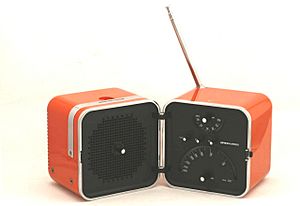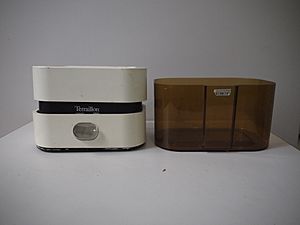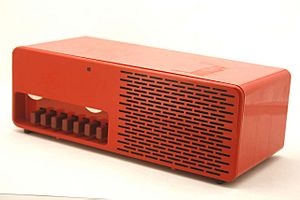Marco Zanuso facts for kids
Marco Zanuso (born May 14, 1916 – died July 11, 2001) was a famous Italian architect and designer. He was a leader in the Modernist movement, which focused on simple, useful, and beautiful designs.
Contents
Early Life and Education
Marco Zanuso was born in Milan, Italy, on May 14, 1916. He was one of many Italian designers from Milan who helped define what "good design" meant after World War II.
He started studying architecture at the Politecnico di Milano university in 1934 and finished in 1939. During World War II, he served in the Italian Navy. After the war, he opened his own design office in 1945.
Early in his career, he was an editor for important design magazines. He worked at Domus from 1947 to 1949 and at Casabella from 1952 to 1956. Here, he helped develop the ideas of the exciting Modern Design movement. He also taught architecture and design at the Politecnico di Milano for many years, from the late 1940s to the 1980s. He was a founding member of the ADI (Association for Industrial Design) in the 1950s. This gave him a big influence on the next generation of Italian designers.
Designing for the Future
Marco Zanuso's career lasted over 60 years. He was very interested in using smart design to solve problems. This led him to explore new ideas in city planning, buildings, and product design. He believed in "good design" and was always curious, searching for new discoveries.
He wanted to find "order in complexity." This meant he was open to new technologies, materials, and designs that made life better for people.
Working with Others
Zanuso worked with many other talented people. In 1957, he teamed up with German designer Richard Sapper. One of their first projects was a small, stackable chair for children. It was made for Kartell using plastic. This chair was light, useful, and fun. It came in bright colors and helped show people that plastic was a good material for modern homes.
In 1959, Zanuso and Sapper became consultants for Brionvega. This Italian company wanted to make stylish electronics that could compete with products from Japan and Germany. They designed many radios and televisions that became famous examples of "techno-functionalism." This style combined technology with simple, useful design.
Their "Doney 14" (1962) was the first fully transistor television. It was rounded, compact, and easy to carry. They also designed the successful folding "Grillo" telephone for Siemens (1966). This was one of the first phones to have the dial and earpiece on the same unit.
In 1972, Zanuso and Sapper designed special living units for an exhibition at the MoMA in New York. These stacking units could unfold into a small apartment with everything needed. Zanuso said they were for "situations that require immediately available, easily transportable living quarters." Their designs were always elegant and imaginative.
Awards and Recognition
Marco Zanuso received many awards for his work. In 1984, he won the Premio Presidente della Repubblica. In 1994, he received the Compasso d’Oro Lifetime Achievement Award. He also received an honorary degree in Industrial Design from the Politecnico di Milano in 1999.
Architectural Projects
While Zanuso and Sapper created amazing industrial designs, Zanuso also explored new ideas in architecture. From his studio in Milan, he designed many buildings in Italy and around the world. He worked on commercial buildings, offices, public spaces, and homes. He always aimed to improve modern society responsibly.
His Olivetti factory (1961) in São Paolo, Brazil, and the new Piccolo Teatro (1996) in Milan, Italy, are well-known examples of his commercial buildings. His home designs also helped change ideas in architecture. Some of these include:
- Casa a Leto di Priolo, Arenzano (1960-1962), in Genoa, Italy.
- Case di vacanza, Arzachena, (1962-1964) in Sardinia, Italy.
- Casa Press, Coromandel Farm (1969-1975) in Lydenburg, South Africa.
- Casa nell'isola di Cavallo (1981-1988) in Corsica.
He also explored how architecture could work with nature. An example is the Cimiterio a la Muda, Longarone, (1967-1973). He worked on this project with Gianni Avon, Francesco Tentori, and famous landscape architect Pietro Porcinai.
Industrial Design Innovations
Marco Zanuso's industrial designs covered many different areas. He experimented with bent metal, created luxurious furniture, and designed sleek plastic products. A key part of his work was being a pioneer in using new materials and making them available to everyone.
Some of his first designs were shown at a competition for low-cost furniture at the MoMA in 1948. His chair design used a new way to attach the fabric seat to a metal frame.
In 1948, Pirelli started a new division called Arflex to design furniture with foam rubber. They asked Zanuso to create their first models. His "Antropus" chair came out in 1949. Then, his "Lady" chair won first prize at the 1951 Milan Triennale. Zanuso loved the new materials, saying they could "revolutionize not only the system of upholstery but also the structural manufacturing and formal potential." He felt his designs could have "visually exciting and new contours" with high industrial quality.
Many of his designs are now in famous museums. These include the Museum of Modern Art in New York City, Triennale Milano, Triennale Tokyo, Vitra Museum, Arflex Museum, and Kartell Museum.
Important Designs
Here are some of Marco Zanuso's most important designs:
- 1951: "Lady" armchair for arflex (won a Gold Medal at the Triennale)
- 1952: "Martingala" armchair for arflex
- 1952: "Tripoltrona" sofa for arflex (won a Gold Medal at the Triennale)
- 1954: "Sleep-o-matic" sofa for arflex (won a Gold Medal at the Triennale)
- 1955: Olivetti buildings in Buenos Aires and San Paolo
- 1960: "Lambda" chair for Gavina (with Richard Sapper)
- 1962: "Doney" television for Brionvega (with Richard Sapper)
- 1963: Alfa Romeo 2600 concept car (with Richard Sapper)
- 1964: "Algol" television for Brionvega (with Richard Sapper)
- 1964: "Woodline" and "Fourline" armchairs for arflex
- 1964: "K 4999" children's chair for Kartell (with Richard Sapper)
- 1965: "TS 502" radio for Brionvega (with Richard Sapper)
- 1966: "Grillo" telephone for Siemens (with Richard Sapper)
- 1969: "Black" television for Brionvega (with Richard Sapper)
- 1970: "Marcuso" table for Zanotta
- 1970: "Hastil" pen for Aurora (with Richard Sapper)
- 1974: IBM building in Milan
- 1998: New theatre Piccolo Teatro in Milan
Images for kids
See also
 In Spanish: Marco Zanuso para niños
In Spanish: Marco Zanuso para niños












